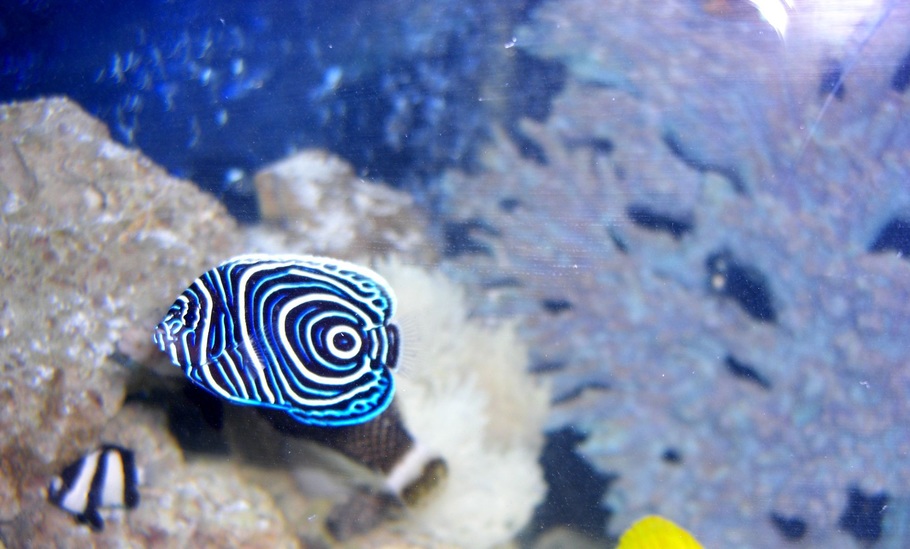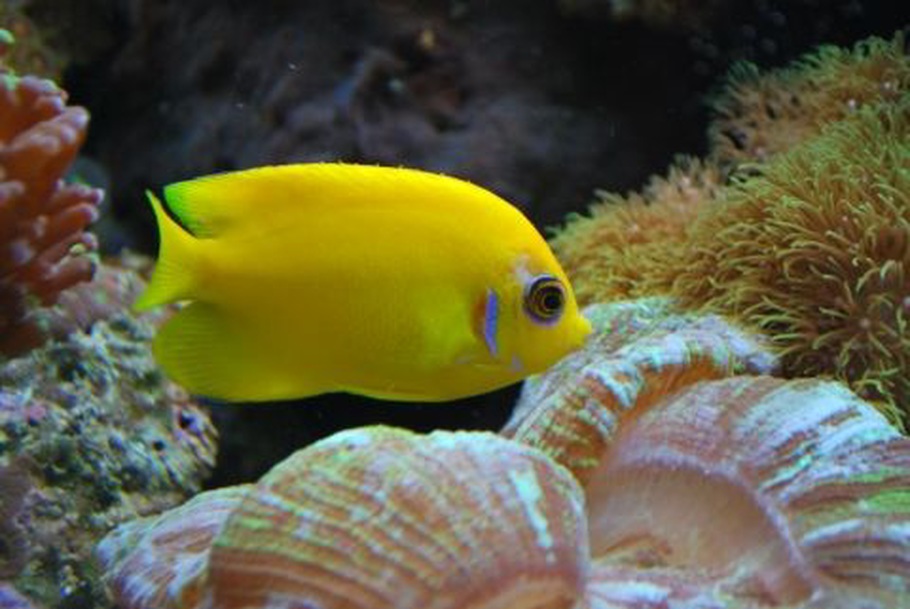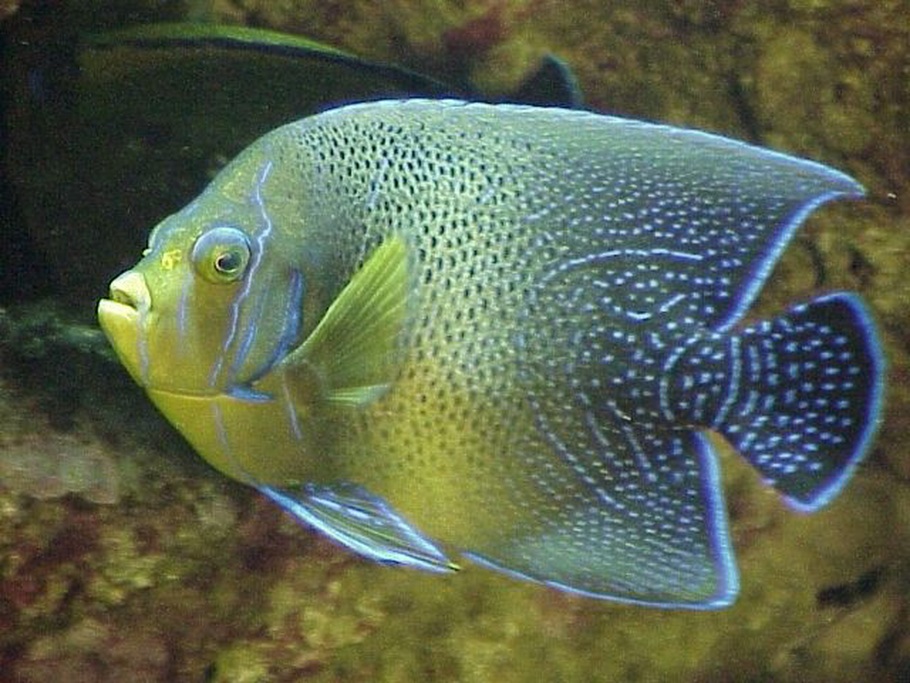SELECTING AND CARING FOR SALTWATER ANGELFISH

Updated
Saltwater angelfish are some of the most colorful saltwater fish available. If you want to keep these fish at home, read more to learn their requirements.
Angelfish are some of the most colorful and uniquely patterned species of saltwater aquarium fish – for many aquarium hobbyists, these fish are the reason they start a saltwater tank. Not only are these fish beautiful to behold, but they are also a joy to keep in the home aquarium. Many species of saltwater angelfish are very hardy by nature and they often adapt well to life in captivity.
In order to ensure that your angelfish thrive, it is necessary to learn the basics about their tank requirements and to keep the tank environment clean and healthy. If you are thinking about adding some saltwater angelfish to your reef tank, or starting a new tank dedicated to these fish, read more to learn how best to care for them.
About Saltwater Angelfish
Saltwater angelfish belong to the family Pomacanthidae which contains over 80 different species. These fish are found primarily in the shallow reefs of tropical regions in the Atlantic and Indian oceans as well as the western portion of the Pacific. This group of fishes is known for its brilliant colors and unique patterns which set them apart from other saltwater species and make them stand out in the reef environment. These fish are very similar in appearance to butterflyfish but they can be distinguished by the strong spines present in their gill covers – angelfish are also generally more adaptable to captivity than butterflyfish.
Most angelfish species exhibit laterally compressed bodies with small mouths and large pectoral fins. Many species also have long extensions streaming out from the dorsal and anal fins. Though size varies according to species, the average size is between 8 and 12 inches for most angelfish. The largest species of angelfish, the Gray angelfish (Pomacantus arcuatus) can reach a length of 24 inches at maturity. In the wild, angelfish generally stick to shallow reef environments, rarely venturing more than 150 feet deep. Most angelfish are diurnal, feeding during the day and hiding among the rocks and crevices in the reef at night.

One of the most interesting qualities about angelfish is that they often experience a color change as they age. In some cases this shift can be very dramatic. Orange angelfish (Genicanthus bellus), for example, exhibit wide black bands as juveniles but eventually develop bright orange bars as they mature. In other species, the color change may be quite different, shifting from the vibrant black-and-white stripes of the juvenile Gray angelfish to a solid gray-colored adult. Unfortunately, the vibrant colors of saltwater angelfish tend to fade somewhat in captivity so you may not see the same coloration in your angelfish as you might see in wild species. Feeding your angelfish a healthy, varied diet will help to promote healthy coloration.
Tank Requirements
Though angelfish can be very hardy in the home aquarium, it is important that the tank environment is set up to their preferred specifications if you want them to thrive. To start, you must have the aquarium up and running for at least 3 months before you add your angelfish to ensure that the nitrogen cycle is fully established in the tank. You will still need to perform routine water changes during this time to keep the ammonia and nitrite levels in your tank under control. For your angelfish to get a healthy start in your tank, you ought to provide them with a healthy environment and that starts with maintaining high water quality in your saltwater tank.
Aside from a fully cycled tank and high water quality, saltwater angelfish have a few other preferences you should know about. While these preferences may vary slightly from one species to another, most angelfish prefer reef tank environments and the size may depend on the species. Small species of angelfish may only require a tank size around 50 gallons while medium and large angelfish require 100 gallons of tank capacity or more. Providing your angelfish with a large tank will help to diminish aggressive tendencies and it will improve your chances of success in keeping angelfish. Before you purchase any angelfish, take the time to research the specific species you are thinking about getting so you can cater your tank conditions to the needs of that particular species. It is important that you strike the right balance in salinity, pH, temperature and other aspects of water chemistry in order for your angelfish to thrive.
Recommended Species
If you want to successfully keep angelfish in your home tank you need to stick to some of the hardier species. These species of angelfish are more likely to accept food in captivity and they generally adapt well to the confined environment of the home tank.
Pearlscale Angelfish (Centropyge vrolicki) - This is one example of saltwater angelfish which is particularly recommended for beginners – though these fish are not the most colorful angelfish, they only grow to 4 inches and they are generally inexpensive.
Queen Angelfish (Holacanthus ciliaris) – This species grows up to 18 inches long and it exhibits a very bright coloration of blue and yellow. The Queen Angelfish is a good beginner species because it is very hardy, but it does require at least 180 gallons in tank capacity. This species is fairly aggressive as well, so you need to be careful about the tank mates you keep it with – it will feed on sponges, jellyfish and various types of phytoplankton. Queen Angelfish should be fed small amounts several times a day.

Emperor Angelfish (Pomacanthus imperator) – This exotic species is sometimes called the Imperial Angelfish and it has a beautiful blue and yellow coloration with horizontal striping and a thick black band across the eyes. The Emperor Angelfish grows up to 16 inches in the wild, but it usually tops out around 12 inches in captivity. This species is moderately hardy and somewhat tricky to care for – it is also semi-aggressive by nature. This angelfish needs a diet rich in sponge and spirulina algae, supplemented with various protein sources like brine shrimp and mysis shrimp. Emperor Angelfish can be kept in aquariums 125 gallons and larger.
Yellow Tail Angelfish (Apolemichthys xanthurus) – Also known as the Xanthurus Cream Angelfish, this species is fairly easy to care for but it is a very aggressive species. The Yellow Tail Angelfish grows up to 8 inches and requires at least 125 gallons in tank capacity. This species has a cream-colored body with a thick black outline and a yellow caudal fin – it also has a dorsal fin outlined in silvery-white. This angelfish tends to nip at stony corals and soft corals so be careful about keeping it in a reef tank.
French Angelfish (Pomacanthus paru – This species has an overall dark gray coloration with myriad gold-tipped scales over the body. When this species is young, they are jet black in color with four yellow stripes that make them look like a bumblebee. The French Angelfish is very hardy which makes it a good choice for beginners but it requires a very large tank – at least 180 gallons, but ideally 250 gallons in capacity. This species grows up to 16 inches in length and it can live for 15 years or longer. French Angelfish are omnivorous and they prefer foods that contain sponge and spirulina algae.

Blueface Angelfish (Pomacanthus xanthometopon) – This species is named for the blue coloration on its face – the rest of its body is also blue with yellow tipping on the scales and a yellow caudal fin. The Blueface Angelfish requires a moderate degree of care and it is a semi-aggressive species so you should use caution when keeping it in a reef tank. This species grows up to 15 inches in length and requires a very large tank, at least 220 gallons in capacity. The Blueface Angelfish will graze on live rock and it requires supplementation with spirulina, shrimp, and other meaty foods.
Some other species you might also have success with Fisher’s angels, Ornate angels, King angels, Six bar angels and blue-faced angels. These species are a little less hardy, however, than the species listed above. Still, if you are able to maintain stable water conditions in your tank they might be a good choice.
Species to Avoid
If you want to raise angelfish in your home tank you want to start off by giving yourself the best chances of success – this means you need to select species that are likely to thrive in captivity. While any fish has the potential to adapt to captive life, certain species of angelfish are known for their decreased adaptability. Some of these species include Hawaiian bandit angelfish (Apolemicthys arcuatus), Barred angelfish (Centropyge multifasciatus), Regal angelfish (Pygoplites diacanthus) and Oriole angelfish (Centropyge bicolor). The main issue with these species is that they often do not adapt to feeding in captivity – while many saltwater fish will only accept live foods, some of these angelfish species may not accept food of any kind in captivity. Some species are also especially prone to disease – like the Barred angelfish – which makes them very difficult to keep. These angelfish may seem to be doing well for a few weeks when, in reality, they are slowly starving to death. In the case of some species, like the Oriole angelfish, less than half of captive specimens survive past 6 months.
Recommended Tank Mates
Saltwater angelfish have been known to become very aggressive toward other angelfish in the tank so you need to choose your tank mates wisely. Few angelfish species are likely to tolerate the presence of other angelfish of the same species in the home tank environment – some may even be aggressive toward other angelfish species of similar appearance. If you do hope to keep more than one angelfish in your tank, do not add them all at the same time. Start off with one small angelfish and add the others slowly over time, giving each of them time to get used to the tank and to establish their own territory. Though angelfish are often aggressive toward others of their kind, they generally tolerate species from other families. Fish like wrasses and clownfish are generally compatible with a variety of angelfish species.

Feeding and Care
In many cases where angelfish fail to thrive in captivity, it is due to inadequate feeding. Angelfish require a varied diet in order to thrive and, if they are not given the proper foods, they may slowly starve to death. Most angelfish will accept live foods like brine shrimp and they may also accept frozen foods such as krill, scallops and shredded shrimp. In some cases, you may be able to adapt your angelfish to accept commercial foods like flakes and pellets. In addition to these foods, you should also be sure to include fresh vegetable matter in the diet of your angelfish – foods like romaine lettuce should account for about one third of the weekly diet of your fish. To ensure that your angelfish thrive, feed no less than five different foods on a weekly basis.
If your angelfish are properly fed and kept in a clean environment they are not likely to suffer from disease. For the most part, saltwater angelfish are hardy against aquarium fish disease but they can still succumb to bacterial and protozoan diseases if they are stressed or if water quality in the tank declines. Saltwater angelfish may also be slightly more prone to developing lateral line erosion which, though not always fatal, can leave permanent scars. Edema, or bloat, is another problem you may see in angelfish – this condition is often fatal in a short period of time. The best way to prevent these diseases from affecting your tank is to bring home healthy specimens and to maintain the tank properly.
Other Info
When choosing the angelfish for your tank, you may want to think about purchasing online rather than from your local pet store. Purchasing online allows you to have more of a selection of species to choose from and it cuts out one step of the shipping process (from the supplier to the pet store), instead having the fish delivered right to your door. Keep in mind that you should avoid species that are very small or very large – small angelfish may require constant feeding and large angelfish may have difficulty adapting to captive life.
If your local pet store has a large selection of saltwater aquarium fish, you may be able to find what you are looking for there. When you visit the pet store, observe the fish before buying to ensure that they are healthy. Look for warning signs like hollowness of the body, rapid breathing and torn or frayed fins which might indicate disease. If any of these indications are present you may want to wait for another shipment to come in or go to a different store entirely. Remember that the healthier your angelfish are when you bring them home, the more likely they are to thrive in your tank.
Now that you know the basics about keeping saltwater angelfish you will be able to cater your tank to their needs and have a better chance of success in raising them.
comments powered by Disqus
































































































